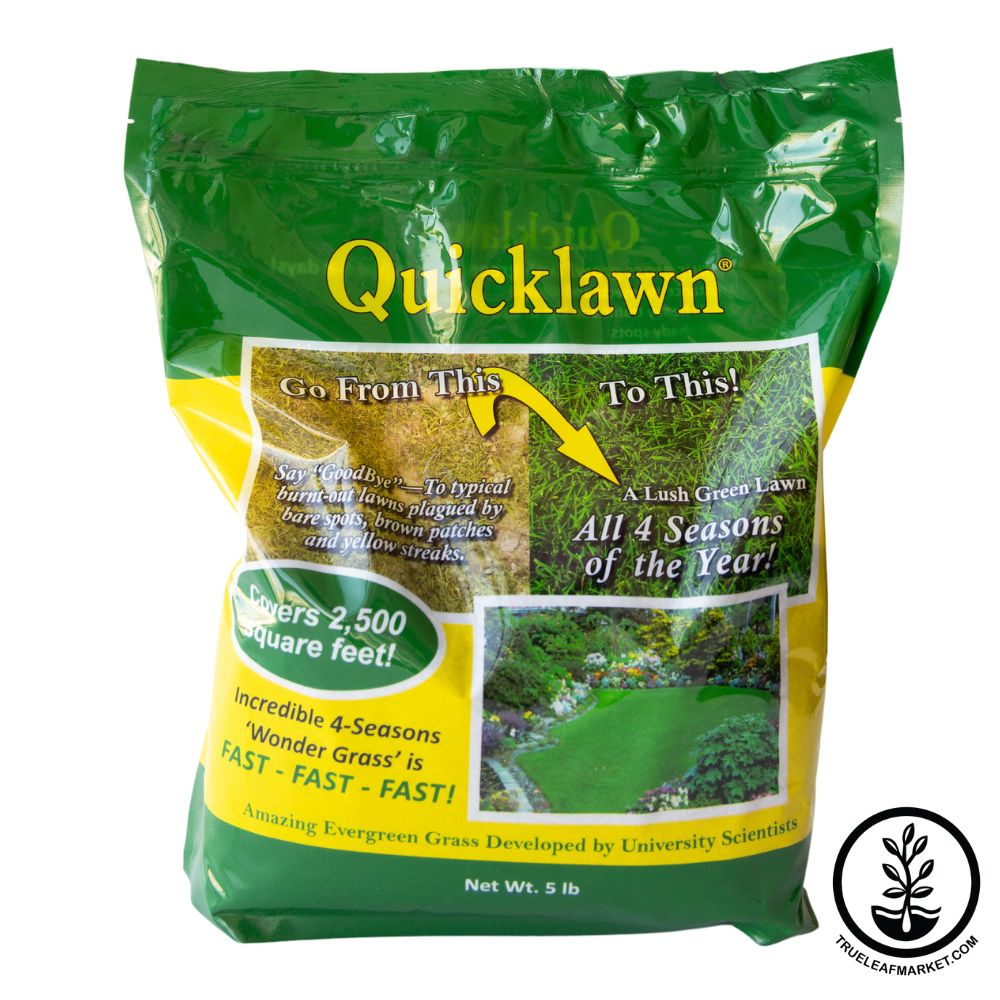Growing an entire lawn from seed can seem daunting, but Quicklawn grass seeds has made the process simple, easy, and exciting with reliable results. Experience success by following our simple guide to growing a lush grass turf lawn. Need to fill in a few bald spots? Don’t worry, we cover that too! Growing a lawn from seed can be easy with the right guidance.
Step 1: Prepare the Soil
Before planting grass seed, the area should be cleared of weeds and debris. Then, lossen the top 6-8 inches of soil. Use a large landscaping rake to level the surface. At this stage of landscaping it is advisable to ensure your land slopes away from your home. During heavy rains, water can gather on top of the surface before filtering through the grass. Dips in a yard may lead to regular mosquito problems as water gathers throughout the season.
Step 2: Grass Seed Selection
Choose a grass seed variety or mix that suits your climate and preferences. For a home lawn we recommend the Quicklawn seed mix that contains kentucky bluegrass, Chantilly creeping red fescue, wicked perennial ryegrass, and express II perennial ryegrass. Mixing a perennial clover such as mini clover lawn seeds can help your lawn stay green while standing up to drought conditions. This particular clover was developed to maintain a traditional lawn height. Other popular grass seeds include the dryland pasture mix or cabin mix that are ideal for erosion control and areas that are not regularly irrigated.
Step 3: Interplanting With Clover
As mentioned above, clover makes a great companion to traditional grass seeds. It can act as a natural fertilizer throughout the year as it is a nitrogen fixing plant. This means it takes nitrogen found in the air and is able to transfer it into the soil for use by itself and surrounding plants. This is all due to the beneficial microbes that work within nodules that form on the roots. Clover is also favored for interplanting as it is very soft. Kids and adults alike often complain of the scratchy feeling grass has against their skin, but clover is soft enough to play in comfortably. While the traditional white dutch clover can be intersown with grass seeds, it will continually grow beyond the traditional lawn height. Instead, opt for the miniature clover for a more uniform height.
Step 4: Seeding A New Lawn
Grass seed is most easily spread by broadcasting or using a mechanical spreader for even distibution. Spread the seeds of a cleared and level growing surface. Sow according to the recommended density of your selected seed. Once the seed is spread, gently rake the area to increase soil-to-seed contact. Lightly tamp the soil.
Step 5: Watering
To establish a lawn it is crucial to maintain moist soil during germination. We recommend using a sprinkler system to avoid disturbing the growing surface. Regardless of what variety of grass or mix you choose to grow, it will need to be watered until it becomes established. If growing a grass mix in a location that will not receive irrigation, plant during the early wet spring season.
Step 6: Germination and Establishment
Be patient. Like all plants, it takes time to grow grass. Usually germination will take a couple of weeks. Quicklawn seeds are known to germinate in as little as 5-8 days. Once the grass reaches 3+ inches it is ready to be mowed for the first time. Keep in mind, allowing it to grow a bit long for the first while will encourage a better root system to handle the stress of being cut down.
Step 7: Fertilization
Occasional fertilization is recommended to maintain a healthy lawn. In addition to a fertilizer regiment, consider applying a compost tea to encourage healthy microbial soil activity.
Step 8: Weed Control and Maintenance
When starting a lawn from seed, the soil is left very exposed. Be sure to watch for weed growth and act promptly. Continue to be vigilant as your new lawn becomes established. Once a weed goes to seed it is increadibly difficult to get ahead of the problem. In addition to weed control, regular maintenance includes watering, mowing, aerating, and scouting for signs of pests and disease.
Step 9: Enjoy Your Green Oasis
While a lawn can be grown for several purposes, such as erosion control, social gatherings, playing space, etc. It is encouraged to limit the lawn space to no more than 70 percent of the landscape. This is not only for pollinator support, but the visual aesthetics a diverse landscape provides. Consider growing an array of flowers and vegetables around your lawn area.
Tips For Filling Dead Spots in the Lawn
Start by identifying why the spots exist. Dead spots are often related to pet bathroom areas or pest problems. If the spots are occurring in the area your pet usually goes to the restroom, start by cleaning up their droppings regularly. Remove the dead patches and fill in the area with seed. Be sure to seclude the area to prevent interference during the growing process by your furry friends.
If the dead spot is not immediately related to a pet, check for grubs. Pulling up the dead patch will often allow you to visually confirm their presence. We recommend treating your lawn if the problem is related to grubs. If allowed to get out of hand a small affected area can become your entire yard.
Contributing Author:
 |
Lara Wadsworth, True Leaf Market Writer |
I am a native of Southwestern Michigan, where I also reside, and I love all things plants! I got a Bachelor's Degree in Horticulture and found the first work-from-home job I could get. Now, I spend my days writing for TLM, playing with my dog, eating delicious food with my husband, and plotting my next landscape or gardening move. I believe everyone should get down and dirty in the soil now and then. Happy Gardening!




















0 comments
No comments yet! Be the first to start a conversation.